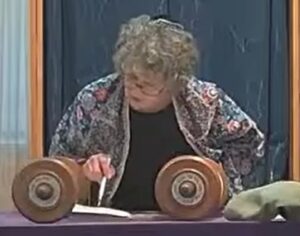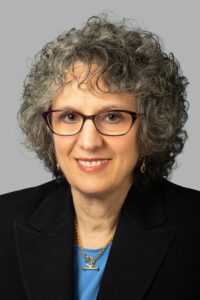One of my fondest wishes as a little girl was to do everything the boys do on the Bimah. From the age of four I attended Junior Congregation accompanying my older brother. It was just the two of us. My father was at work, and my mother had gone to shul on Friday night and was enjoying a shabbat of her own making at home. By age five I knew all the prayers by heart. The service was held in a small, simple room in the basement of our synagogue. It was filled with children, and it resonated with laughter and song. There I learned to daven, I was a chazanit, I had aliyot, I held the Torah, I sat on the Bimah. All the “jobs” were accessible to me. One shabbat, after a major snowfall, when it was too dangerous for our mother to drive us, my brother and I trudged through the heavy snow to the synagogue so that we would not miss the service.
When I moved upstairs to the grownup service, the situation changed radically. Suddenly the Bimah was a place reserved exclusively for men. A girl could not be called up to the Torah or carry the Torah around the synagogue or daven. Once a year on Simchat Torah I was thrilled to have an aliyah to the Torah along with all the other girls and women. I remember the excitement of ascending the Bimah, of being covered by a huge Talit, of being close to the Torah and reciting the blessings.
I used to fall asleep every Friday night listening to my brother prepare his Torah reading for Shabbat morning, The rhythmic cadences of his chanting lulled me into a pleasant reverie. He would repeat each line over and over until he had mastered it– and on Shabbos morning there he was on the Bimah with all the other boys reading from the Torah.
My Bat-Mitzvah took place on Friday night. I chanted the kiddush, which was appropriate, and the Haftorah, which was totally out of context. On Shabbat morning my brother and friends read from the Torah, and my teacher chanted the Haftorah. I was permitted to lead the Ashrei.
What made the situation even more poignant for me was that my teacher, Kenny Goldblum, had taught me “as though I were a boy.” For months we studied together every shabbat afternoon sitting across from each other in his den on the first floor. He taught me each trop note one by one so that I would remember. There were no tapes or recordings. I listened to him and I practiced. We discussed the meaning of the Haftorah and how it related to the Torah portion. He knew so much and valued each question and always gave a reasoned answer! He taught all of his students how to have poise on the Bimah, how to look down at the Haftorah book yet maintain eye contact with the congregation, how to breathe, what to do if we forgot a note. All of his students were lifers– whatever we learned we remembered for life.
Change came slowly to synagogue life. When my second niece had a baby naming in early 1980, I became the first woman to chant the Haftorah at her synagogue. I watched as three men left the synagogue before I even sang the first blessing. At that moment I no longer existed for myself alone. I was every woman, and I was determined to do a perfect job. I found it thrilling.
When I first came to Shomrei Emunah I noticed the Haftorah honor was often given out during the service, and the Gabbai was always looking for someone to chant the Haftorah. When I asked if I could chant a Haftorah, one of the male members objected because he didn’t know me and besides I was a woman. Rabbi Rank persuaded him to give me a chance, and I have been chanting every since!
 In my thirties I finally learned to read Torah, assisted by a tape from my Torah teacher– not the way he liked to teach but unavoidable since we now lived in different states. First he chanted the Torah Trop and then he sang the first aliyah of Beresheet. I practiced the trop while I was carpooling and listened to the tape over and over. It was not the same, but at least Kenny was with me in spirit on my learning journey. When I later read Torah in a synagogue in North Hampton, Massachusetts at a cousin’s bar mitzvah someone came up to me and said– did Kenny Goldblum teach you how to read Torah? I was proud to be Kenny’s disciple and to pass the trop I learned from him and those skills onto my three daughters.
In my thirties I finally learned to read Torah, assisted by a tape from my Torah teacher– not the way he liked to teach but unavoidable since we now lived in different states. First he chanted the Torah Trop and then he sang the first aliyah of Beresheet. I practiced the trop while I was carpooling and listened to the tape over and over. It was not the same, but at least Kenny was with me in spirit on my learning journey. When I later read Torah in a synagogue in North Hampton, Massachusetts at a cousin’s bar mitzvah someone came up to me and said– did Kenny Goldblum teach you how to read Torah? I was proud to be Kenny’s disciple and to pass the trop I learned from him and those skills onto my three daughters.
When I turned fifty, I learned the entire Parashah of Chayye Sarah, which was the parashah I would have chanted had I been a boy when I turned thirteen. I had a second bat mitzvah leading the service and chanting the entire Torah portion and the haftorah. I love the cadence of the notes, the unfolding of the story, the repetition of certain ideas, first the thinking, then the doing, then the re-telling. Reading from the Torah makes me feel connected to the text. I am a storyteller for the congregation emphasizing what the trop already tells us is important. I am so glad that I and our mothers, daughters, sisters and friends have been give this opportunity to be counted, to lead, to chant, to tell the story of our people from the Bimah, just like the boys.
- Music Connects our Community - Thu, Oct 5, 2023
- Learning to Read Torah - Thu, Mar 31, 2022


Your story is fascinating! Thank you for sharing.
A beautiful story Judy. May you always find shalom with the Torah.
I came upon this while going down an internet rabbit hole…. so beautiful, Judy. I recall you as a wonderful ba’alat koreh, Torah reader. And yes, you have described beautifully how wonderful it is to have the privilege of bringing the words alive to one’s community.
May you continue to go from strength to strength!